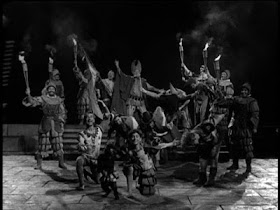 In Olivier's version, the players only appear after Hamlet has his arranged encounter with Ophelia and "To be or not to be". Though a different moment altogether, it is still a dark one for Hamlet who, in the normal sequence, is meditating on melancholy. Olivier's flights of expressionism thus cast Hamlet in a dark space. Symbolically, Polonius walks in with a torch that illuminates the Prince. And when the players come in (with many torches), the room, which might as well have been the dark of night, fills with light. Polonius' arrival and subsequent announcement of the players gives Hamlet the glimmer of an idea, and that arrival a new sense of purpose, all of it expressed with lighting as much as acting. Polonius reads from a parchment - Felix Aylmer is as amusing as usual - and doesn't know what to make of "He that plays the king shall be welcome."
In Olivier's version, the players only appear after Hamlet has his arranged encounter with Ophelia and "To be or not to be". Though a different moment altogether, it is still a dark one for Hamlet who, in the normal sequence, is meditating on melancholy. Olivier's flights of expressionism thus cast Hamlet in a dark space. Symbolically, Polonius walks in with a torch that illuminates the Prince. And when the players come in (with many torches), the room, which might as well have been the dark of night, fills with light. Polonius' arrival and subsequent announcement of the players gives Hamlet the glimmer of an idea, and that arrival a new sense of purpose, all of it expressed with lighting as much as acting. Polonius reads from a parchment - Felix Aylmer is as amusing as usual - and doesn't know what to make of "He that plays the king shall be welcome."In the absence of Rosencrantz & Guildenstern, there is a certain irony to Polonius being the bearer of news that will undo him and his corrupt king.
 From the Players' entrance, Hamlet enters a manic state, delivering lines at a furious pace, often preventing anyone from interjecting. This will be a much shorter scene, heavily cut and missing the Priam speech. "I am glad to see thee well" is spoken to a dog walking on its hind legs, eliciting some laughs. The "lady" is an historically accurate boy. The bearded player is First Player, which makes the character younger that he appears (a mirror of Hamlet's own, doubtful age?). Of course it could just mean he grew a beard, but the text does mean to refer to an actor getting older. Harcourt Williams who plays the First Player was already in his late 60s however. Olivier plays on expectations when choosing his lines' targets to amusing effect, but doesn't really squeeze extra meaning from the text.
From the Players' entrance, Hamlet enters a manic state, delivering lines at a furious pace, often preventing anyone from interjecting. This will be a much shorter scene, heavily cut and missing the Priam speech. "I am glad to see thee well" is spoken to a dog walking on its hind legs, eliciting some laughs. The "lady" is an historically accurate boy. The bearded player is First Player, which makes the character younger that he appears (a mirror of Hamlet's own, doubtful age?). Of course it could just mean he grew a beard, but the text does mean to refer to an actor getting older. Harcourt Williams who plays the First Player was already in his late 60s however. Olivier plays on expectations when choosing his lines' targets to amusing effect, but doesn't really squeeze extra meaning from the text.Since there is no recital, Hamlet quickly asks them to follow Polonius, and as they go, so does the light. However, Hamlet is now facing front, a reversal of his initial position. He is ready to take a step forward (the play within a play), moving away from the introspection and back-and-forth that has been the crux of the play since his silent visit of Ophelia. In his reconfigured sequence, Olivier loads Hamlet's inaction in the front end of the play, rather than allow ambivalence between thinking up and enacting his guilt-revealing scheme.

No comments:
Post a Comment